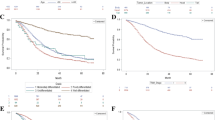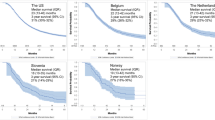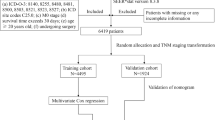Abstract
Background
Prognostic prediction had been widely used in various cancer entities, from early screening to end-stage patient caring. Currently, there is hardly any well-validated nomogram which exists for long-term survival prediction in pancreatic adenocarcinoma (PC) patients in a post-surgery setting. Our objectives are to identify possible prognostic factors in PC patients following radical resection and to develop a prognostic nomogram based on independent survival predictors.
Methods
From 2009 to 2014, a total of 432 PC patients who underwent curative intended surgeries with complete follow-up data were included in this current retrospective long-term survival analysis. Clinicopathological data were extracted from medical records, and all missing values (percentage 0.9–8.3%) were imputed five times with the “PMM” method. Cox proportional hazards models were utilized. A nomogram was formulated based on results from the multivariate regression model so as to predict OS at 1-, 2- and 3-year as well as median OS. Validations, including discrimination and calibration, were carried out with 1000 bootstrap resamples. External validation was conducted in order to verify the accuracy of our nomogram at 1 and 2 years by utilizing the clinicopathological data of 122 PC patients who underwent curative intended surgeries in 2015 in our centre.
Results
Age, abdominal pain, back pain, tumour location, preoperative neutrophil–lymphocyte ratio, preoperative CA19-9, tumour differentiation, microscopic nerve invasion, microscopic vascular invasion, T stage, lymph node ratio, M stage and adjuvant chemotherapy were all assembled into nomogram. The concordance index (C-index) of internal and external validation was 0.702 and 0.688, respectively. The C-index of the TNM staging system was 0.572 (P < 0.001 vs. nomogram).
Conclusion
Our prognostic nomogram based on clinicopathological parameters shows good performance in long-term survival prediction in PC patients following radical surgery and could play a role in further clinical utilization.



Similar content being viewed by others
References
Bailey P, Chang DK, Nones K, Johns AL, Patch AM, Gingras MC et al (2016) Genomic analyses identify molecular subtypes of pancreatic cancer. Nature 531(7592):47–52
Rahman SH, Urquhart R, Molinari M (2017) Neoadjuvant therapy for resectable pancreatic cancer. World J Gastrointest Oncol 9(12):457–465
Neoptolemos JP, Palmer DH, Ghaneh P, Psarelli EE, Valle JW, Halloran CM et al (2017) Comparison of adjuvant gemcitabine and capecitabine with gemcitabine monotherapy in patients with resected pancreatic cancer (ESPAC-4): a multicentre, open-label, randomised, phase 3 trial. Lancet 389(10073):1011–1024
Hackert T, Strobel O, Michalski CW, Mihaljevic AL, Mehrabi A, Muller-Stich B et al (2017) The TRIANGLE operation—radical surgery after neoadjuvant treatment for advanced pancreatic cancer: a single arm observational study. HPB (Oxford) 19(11):1001–1007
Siegel RL, Miller KD, Jemal A (2016) Cancer statistics, 2016. CA Cancer J Clin 66(1):7–30
Brennan MF, Kattan MW, Klimstra D, Conlon K (2004) Prognostic nomogram for patients undergoing resection for adenocarcinoma of the pancreas. Ann Surg 240(2):293–298
Riley RD, Hayden JA, Steyerberg EW, Moons KG, Abrams K, Kyzas PA et al (2013) Prognosis research strategy (PROGRESS) 2: prognostic factor research. PLoS Med 10(2):e1001380
Moons KG, Royston P, Vergouwe Y, Grobbee DE, Altman DG (2009) Prognosis and prognostic research: what, why, and how? BMJ 338:b375
Kattan MW, Karpeh MS, Mazumdar M, Brennan MF (2003) Postoperative nomogram for disease-specific survival after an R0 resection for gastric carcinoma. J Clin Oncol 21(19):3647–3650
Bochner BH, Kattan MW, Vora KC (2006) Postoperative nomogram predicting risk of recurrence after radical cystectomy for bladder cancer. J Clin Oncol 24(24):3967–3972
Weiser MR, Landmann RG, Kattan MW, Gonen M, Shia J, Chou J et al (2008) Individualized prediction of colon cancer recurrence using a nomogram. J Clin Oncol 26(3):380–385
Ferrone CR, Kattan MW, Tomlinson JS, Thayer SP, Brennan MF, Warshaw AL (2005) Validation of a postresection pancreatic adenocarcinoma nomogram for disease-specific survival. J Clin Oncol 23(30):7529–7535
Hartwig W, Vollmer CM, Fingerhut A, Yeo CJ, Neoptolemos JP, Adham M et al (2014) Extended pancreatectomy in pancreatic ductal adenocarcinoma: definition and consensus of the International Study Group for Pancreatic Surgery (ISGPS). Surgery 156(1):1–14
Bassi C, Marchegiani G, Dervenis C, Sarr M, Abu Hilal M, Adham M et al (2017) The 2016 update of the International Study Group (ISGPS) definition and grading of postoperative pancreatic fistula: 11 years after. Surgery 161(3):584–591
Harrell FE Jr, Lee KL, Mark DB (1996) Multivariable prognostic models: issues in developing models, evaluating assumptions and adequacy, and measuring and reducing errors. Stat Med 15(4):361–387
Hanley JA, McNeil BJ (1982) The meaning and use of the area under a receiver operating characteristic (ROC) curve. Radiology 143(1):29–36
Heagerty PJ, Lumley T, Pepe MS (2000) Time-dependent ROC curves for censored survival data and a diagnostic marker. Biometrics 56(2):337–344
Wan G, Gao F, Chen J, Li Y, Geng M, Sun L et al (2017) Nomogram prediction of individual prognosis of patients with hepatocellular carcinoma. BMC Cancer 17(1):91
Proctor MJ, McMillan DC, Morrison DS, Fletcher CD, Horgan PG, Clarke SJ (2012) A derived neutrophil to lymphocyte ratio predicts survival in patients with cancer. Br J Cancer 107(4):695–699
Yang JJ, Hu ZG, Shi WX, Deng T, He SQ, Yuan SG (2015) Prognostic significance of neutrophil to lymphocyte ratio in pancreatic cancer: a meta-analysis. World J Gastroenterol 21(9):2807–2815
Mowbray NG, Griffith D, Hammoda M, Shingler G, Kambal A, Al-Sarireh B (2018) A meta-analysis of the utility of the neutrophil-to-lymphocyte ratio in predicting survival after pancreatic cancer resection. HPB (Oxford) 20(5):379–384
Xu J, Shi KQ, Chen BC, Huang ZP, Lu FY, Zhou MT (2017) A nomogram based on preoperative inflammatory markers predicting the overall survival of pancreatic ductal adenocarcinoma. J Gastroenterol Hepatol 32(7):1394–1402
Hamada S, Masamune A, Shimosegawa T (2013) Inflammation and pancreatic cancer: disease promoter and new therapeutic target. J Gastroenterol 49(4):605–617
Sadot E, Basturk O, Klimstra DS, Gonen M, Lokshin A, Do RK et al (2015) Tumor-associated neutrophils and malignant progression in intraductal papillary mucinous neoplasms: an opportunity for identification of high-risk disease. Ann Surg 262(6):1102–1107
Li Y, Sun J, Jiang Z, Zhang L, Liu G (2015) Gemcitabine and S-1 combination chemotherapy versus gemcitabine alone for locally advanced and metastatic pancreatic cancer: a meta-analysis of randomized controlled trials in Asia. J Chemother 27(4):227–234
Uesaka K, Boku N, Fukutomi A, Okamura Y, Konishi M, Matsumoto I et al (2016) Adjuvant chemotherapy of S-1 versus gemcitabine for resected pancreatic cancer: a phase 3, open-label, randomised, non-inferiority trial (JASPAC 01). Lancet 388(10041):248–257
Hamada C, Okusaka T, Ikari T, Isayama H, Furuse J, Ishii H et al (2017) Efficacy and safety of gemcitabine plus S-1 in pancreatic cancer: a pooled analysis of individual patient data. Br J Cancer 116(12):1544–1550
Berger AK, Abel U, Komander C, Harig S, Jager D, Springfeld C (2014) Chemotherapy for advanced pancreatic adenocarcinoma in elderly patients (≥70 years of age): a retrospective cohort study at the National Center for Tumor Diseases Heidelberg. Pancreatology 14(3):211–215
Merkow RP, Bilimoria KY, Tomlinson JS, Paruch JL, Fleming JB, Talamonti MS et al (2014) Postoperative complications reduce adjuvant chemotherapy use in resectable pancreatic cancer. Ann Surg 260(2):372–377
Pu N, Lv Y, Zhao G, Lee W, Nuerxiati A, Wang D et al (2018) Survival prediction in pancreatic cancer patients with no distant metastasis: a large-scale population-based estimate. Future Oncol 14(2):165–175
Miao Y, Jiang K, Cai B, Yin L, Dai C (2017) Artery divestment for artery involved pancreatic cancer: a retrospective study. Pancreatology 17(4):S25–S26
Showalter TN, Winter KA, Berger AC, Regine WF, Abrams RA, Safran H et al (2011) The influence of total nodes examined, number of positive nodes, and lymph node ratio on survival after surgical resection and adjuvant chemoradiation for pancreatic cancer: a secondary analysis of RTOG 9704. Int J Radiat Oncol Biol Phys 81(5):1328–1335
Elshaer M, Gravante G, Kosmin M, Riaz A, Al-Bahrani A (2017) A systematic review of the prognostic value of lymph node ratio, number of positive nodes and total nodes examined in pancreatic ductal adenocarcinoma. Ann R Coll Surg Engl 99(2):101–106
Tarantino I, Warschkow R, Hackert T, Schmied BM, Buchler MW, Strobel O et al (2017) Staging of pancreatic cancer based on the number of positive lymph nodes. Br J Surg 104(5):608–618
Tol JA, Gouma DJ, Bassi C, Dervenis C, Montorsi M, Adham M et al (2014) Definition of a standard lymphadenectomy in surgery for pancreatic ductal adenocarcinoma: a consensus statement by the International Study Group on Pancreatic Surgery (ISGPS). Surgery 156(3):591–600
Adamska A, Domenichini A, Falasca M (2017) Pancreatic ductal adenocarcinoma: current and evolving therapies. Int J Mol Sci 18(7):1338
Tao L, Yuan C, Ma Z, Jiang B, Xiu D (2017) Surgical resection of a primary tumor improves survival of metastatic pancreatic cancer: a population-based study. Cancer Manag Res 9:471–479
Funding
Funding was provided by the National Natural Science Foundation of China (Grant No. 81672449), Clinical Frontier Technology of Jiangsu Science and Technology Department (Grant No. BE2016788) and the National Science Foundation for Young Scientists of China (Grant No. 81703301).
Author information
Authors and Affiliations
Corresponding authors
Ethics declarations
Informed consent
Informed consent was obtained from all individual participants included in the study.
Additional information
Publisher's Note
Springer Nature remains neutral with regard to jurisdictional claims in published maps and institutional affiliations.
Electronic supplementary material
Below is the link to the electronic supplementary material.
Rights and permissions
About this article
Cite this article
Xu, D., Zhang, K., Li, M. et al. Prognostic Nomogram for Resected Pancreatic Adenocarcinoma: A TRIPOD-Compliant Retrospective Long-Term Survival Analysis. World J Surg 44, 1260–1269 (2020). https://doi.org/10.1007/s00268-019-05325-z
Published:
Issue Date:
DOI: https://doi.org/10.1007/s00268-019-05325-z




